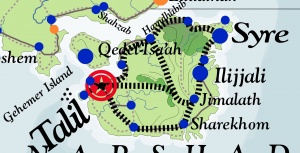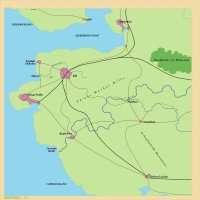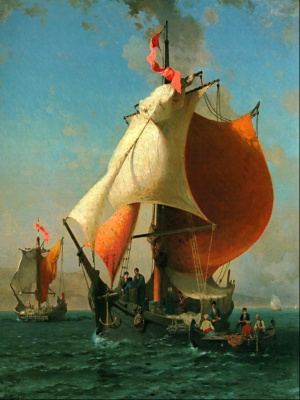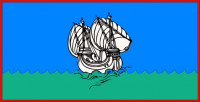Narshad
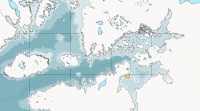
The island of Narshad is the core territory of the Narsadese Republic and the cultural center of the Narshadic people. It is the largest island of the islands of the republic and rests in the western Memnosian Sea. Narshad is a larger island with three major cities, the capital Talil, and the great merchant cities of Syre, and Ashenith. Narshad is the commercial hub of the western Memnosian Sea. The principle people of Narshad are the Narsadese, descended from the ancient Narshadite people who are of Thammazite heritage. The chief language of the island is Narsadese, part of the Thammazic Language family and related to Cospian and Khahonri. Most Narsadese consider themselves worshipers of the old Thammazite gods. There is a considerable Incarnandist minority on the island, followed by a much smaller Arathracian minority. Many human foreigners dwell as residents or even permanent residents in Narshad thanks to its commercial influence. The largest human minorities are refugees and merchants from Khesheph and Ebinóë. A small minority of Gorcorumbese giants chose to continue to dwell on the island as permitted by the Treaty of Johaulia (2685) following the Merchants War. Most Narsadese practice the Imzaha religion with a small but significant Incarnandist minority.
Name
The name 'Narshada' is from ancient Thammazite, 'Nara-shada.'
Asdarography and Climate
The island of Narshad rests in the western Memnosian Sea which is known as the Sea of Narshad. The island rests close to the Ambrinquan Peninsula and the neighboring land of Khesheph which is subject to the Gorcorumbese Empire of the Ephysgæes. In the Gehemerite Strait between Narshad and Khesheph rests the neighboring island of Gehemer. Mountains rest in the eastern half of the island. The northeastern portion of the island is heavily wooded with Cospian Cedars. The longest river on Narshad is the S'ahumoth River of which the Liy'haquph River is the largest tributary.
Middle to Western Narshad
The S'ahumoth River flows to the west coast of Narshad. Western Narshad is abundant in crops of wheat, rye, and vegetables. The lands around the S'ahumoth River are called the S'ahumoth Plains. In addition to farms for grain, they are used for grazing of sheep and other cattle. The occasional wealthy villa surrounded with vineyards and olive orchards can be found here, often the first home of prosperous farmers or the second home a wealthy merchant family. The Th'abi Wushal Hills separate the plains of the S'ahumoth River from the north plain where the capital city of Talil and the Stream of Yaharaphi flows into the sea. The Ashaphuhedh Mountains to the south of the S'ahumoth Plains receive of snow on their highest peaks in the winter. Northeast of the S'ahumoth River is wooded and known as the Woodlands of Thuwwat where cult practices to the goddess Thuwwat were exercised in ancient times.
Narshad enjoys the ameliorating breezes of the sea. The climate is somewhat cool in the winter and warm with high humidity in the summer relieved only by hot dry gusts of wind from Danona in the mid to late summer.
Commerce
Narsadese corpora mercia are making important contributions to the development of marine titancraft vessels for commerce and industry, including advancements in speed and tonnage of its titancraft vessels. Smaller merchants continue to employ traditional windships. In addition to its role as a commercial sea emporium, Narshad is an important destination for aerial merchants. The Narsadese merchant marine is well represented in the locks of the Shadmaus and ships grain throughout Thyria. It is often said that when Aurician merchants cannot find something, they go to Talil, Narshad. Narshad is also famous for its fishing fleets. The most powerful international Narsadese corpora mercia include the Memnosian Pearl and Trans-Weshif Commerce.
Narsadese Republic
Narshad was liberated in 2684 from the Gorcorumbese Empire. The Treaty of Johaulia (2685) provided for the existence of an independent state in Narshad. Historically, the Narsadese people have been famous merchants throughout the Pallathantic Region. The Narsadese Republic is governed by the Shu'ah, a body of the ruling Mercantile Entities. The Shu'ah convenes in the Jehimzalya Palace in Talil and is composed of representatives from merchant families, companies, and corpora mercia. One of the qualifications of membership in the body is the payment of an annual tax based on representation and net worth. Commercial interests that are not part of the body are immune to payment of this tax. It is possible for a citizen never to pay any tax his entire life. For this reason, the republic is a tax haven and has drawn corpora mercia of small to middle ventures to establish their headquarters in Narshad.
The Republic has embassies throughout the west, especially in Aurice, Shaprashilara Lum, Beh-Shelub, Elystrio, Verdida, Bryndyd, and Selexis which are major trading destinations for Narshad's merchant marine. Narshad has recently made several cooperative trade agreements with Xsys. Magistrates of the Gorcorumbese Empire have occasionally accused Narshad as being a haven for political dissidents and revolutionaries against the Ephysgæan regime. Treaties with Aurice, Republic of Ithatia, Oliblish, and the Sultanate of Beph-Themesh have secured Narshad from the military might of its neighbor, Gorcorumb. Thanks to these promises of protection, Narshad has been able to focus its wealth and energy on commercial enterprises.
Religion and Culture
Most Narsadese are Imzaami and the Imzaha religion plays an important part in the lives the Narsadese. Imzaami missionaries brought the message of Ammudiyn the Seer to Narshad in the fourteenth century, converting the ancestors of modern-day Narsadese. A minority of Narsadese citizens, especially in the cities, practice Incarnandism. In the rural towns of Narshad are a large minority of worshipers of the old Thammazite Gods which are tolerated. The worship of chaos gods is officially proscribed and done only in great secrecy. The worship of devils is also proscribed, due to Imzaami influence, and sometimes practitioners of the Old Religion are wrongly accused of worshiping devils. Other minority religions include Arathracianism. Chaos Worship is proscribed by the legal code, some aspects of which originate from the Imzaha Religion.
Major Cities
Talil
Syre
See Also
- Gehemer
- Khesheph
- List of the Kings of Narshad
- Memnosian Sea
- Narsadese Republic
- List of Notable Narsadese
| This article is a stub. It requires further development by the creator. |
